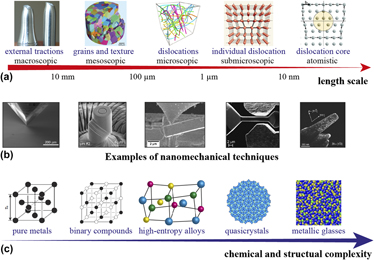No CrossRef data available.
Published online by Cambridge University Press: 04 June 2018

In the past decade, nanomechanical techniques have become ubiquitous for mechanical measurement concurrently with the discovery of high-entropy alloys (HEAs). Different from large-scale testing, small-scale measurements offer quantitative details about mechanical behavior of materials at the micro/nanoscale, presenting new opportunities to probe fundamental nature of HEAs. This article will review the literature on using versatile nanomechanical tools for HEA studies, including nanoindentation, microcompression, high-temperature deformation, fracture measurement, and in situ electron microscopy. With these approaches, many interesting phenomena and properties of HEAs have been unveiled, for example, properties about incipient plasticity, strain-rate sensitivity, creep, diffusion, size-dependent strength, and fracture, which are difficult, or impossible, to be measured in macroscopic experiments. Despite current literature only focusing on a few HEA compositions and several methods, as nanomechanics and HEAs are developing rapidly, a new avenue of research is to be exploited. The article concludes with perspectives about future directions in this field.
This section of Journal of Materials Research is reserved for papers that are reviews of literature in a given area.